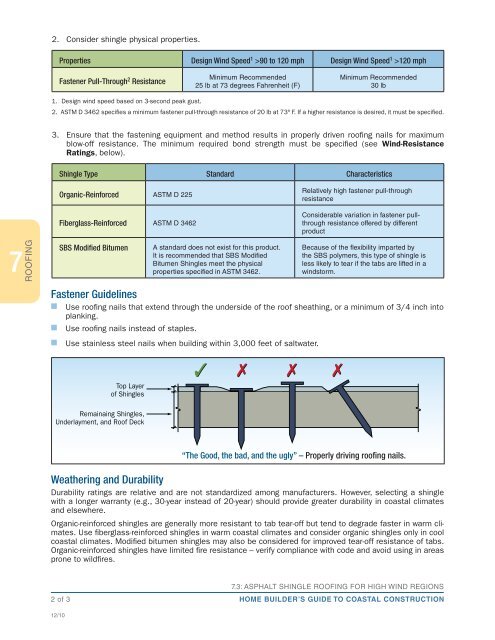FEMA P-499: Home Builder's Guide to Coastal Construction
FEMA P-499: Home Builder's Guide to Coastal Construction
FEMA P-499: Home Builder's Guide to Coastal Construction
Create successful ePaper yourself
Turn your PDF publications into a flip-book with our unique Google optimized e-Paper software.
7<br />
ROOFING<br />
2. Consider shingle physical properties.<br />
2 of 3<br />
12/10<br />
Properties Design Wind Speed 1 >90 <strong>to</strong> 120 mph Design Wind Speed 1 >120 mph<br />
Fastener Pull-Through 2 Resistance<br />
Minimum Recommended<br />
25 lb at 73 degrees Fahrenheit (F)<br />
Minimum Recommended<br />
30 lb<br />
1. Design wind speed based on 3-second peak gust.<br />
2. ASTM D 3462 specifies a minimum fastener pull-through resistance of 20 lb at 73º F. If a higher resistance is desired, it must be specified.<br />
3. Ensure that the fastening equipment and method results in properly driven roofing nails for maximum<br />
blow-off resistance. The minimum required bond strength must be specified (see Wind-Resistance<br />
Ratings, below).<br />
Shingle Type Standard Characteristics<br />
Organic-Reinforced ASTM D 225<br />
Fiberglass-Reinforced ASTM D 3462<br />
SBS Modified Bitumen<br />
A standard does not exist for this product.<br />
It is recommended that SBS Modified<br />
Bitumen Shingles meet the physical<br />
properties specified in ASTM 3462.<br />
Relatively high fastener pull-through<br />
resistance<br />
Considerable variation in fastener pullthrough<br />
resistance offered by different<br />
product<br />
Because of the flexibility imparted by<br />
the SBS polymers, this type of shingle is<br />
less likely <strong>to</strong> tear if the tabs are lifted in a<br />
winds<strong>to</strong>rm.<br />
Fastener <strong>Guide</strong>lines<br />
n Use roofing nails that extend through the underside of the roof sheathing, or a minimum of 3/4 inch in<strong>to</strong><br />
planking.<br />
n Use roofing nails instead of staples.<br />
n Use stainless steel nails when building within 3,000 feet of saltwater.<br />
Top Layer<br />
of Shingles<br />
Remainaing Shingles,<br />
Underlayment, and Roof Deck<br />
“The Good, the bad, and the ugly” – Properly driving roofing nails.<br />
Weathering and Durability<br />
Durability ratings are relative and are not standardized among manufacturers. However, selecting a shingle<br />
with a longer warranty (e.g., 30-year instead of 20-year) should provide greater durability in coastal climates<br />
and elsewhere.<br />
Organic-reinforced shingles are generally more resistant <strong>to</strong> tab tear-off but tend <strong>to</strong> degrade faster in warm climates.<br />
Use fiberglass-reinforced shingles in warm coastal climates and consider organic shingles only in cool<br />
coastal climates. Modified bitumen shingles may also be considered for improved tear-off resistance of tabs.<br />
Organic-reinforced shingles have limited fire resistance – verify compliance with code and avoid using in areas<br />
prone <strong>to</strong> wildfires.<br />
7.3: ASPHALT SHINGLE ROOFING FOR HIGH WIND REGIONS<br />
HOME BUILDER’S GUIDE TO COASTAL CONSTRUCTION


